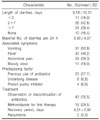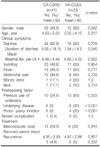Abstract
Purpose
Recent studies have reported an increase in the incidence of community-acquired Clostridium difficile-associated disease (CA-CDAD) among children. There is an overall lack of information on CA-CDAD in the pediatric population. The aim of our study was to compare the epidemiologic and clinical features between CA-CDAD and hospital-acquired C. difficile-associated disease (HA-CDAD) in children.
Methods
We retrospectively reviewed the medical records of all patients who were diagnosed with C. difficile-associated disease (CDAD) at Gil Hospital between April 2008 and March 2009. The diagnosis of CDAD was made when patients with gastrointestinal symptoms had positive results for C. difficile toxins A and B assay or stool culture.
Results
Sixty-one (male, 32 and female, 29) patients were included. The mean age was 3.79±4.54 years. Of the 61 patients, 22 (36.1%) were <1 year of age. Twenty-three patients (37.7%) had a history of antibiotic exposure in the previous 3 months. Forty-one patients (67.2%) were diagnosed with CA-CDAD. There were no significant differences in age, gender, symptoms, laboratory findings, recovery period, complications, and recurrence between the CA-CDAD and HA-CDAD groups. On the other hand, exposure to antibiotics was significantly more frequent among patients in the HA-CDAD group (p=0.005).
Conclusion
This study suggests that the occurrence of CA-CDAD is increasing in the pediatric population, especially in younger children with no history of exposure to antibiotics and in outpatients. Awareness of the increasing incidence of CA-CDAD and prompt investigation of C. difficile in susceptible patients is needed to avoid misdiagnosis and for appropriate therapy.
Figures and Tables
 | Fig. 1(A) Sixty-one patients with Clostridium difficile-associated disease (CDAD) are arranged according to age (year). The gray and black columns represent cases of community-acquired CDAD and hospital-acquired CDAD, respectively. (B) Age-specific distribution of 61 patients with CDAD shows progressive decrease in the number of patients after 1~4 years of life. |
References
1. Lee JH, Lee SY, Kim YS, Park SW, Jo SY, Ryu SH, et al. The incidence and clinical features of Clostridium difficile infection; single center study. Korean J Gastroenterol. 2010. 55:175–182.

2. Kim BC, Yang HR, Jeong SJ, Lee KH, Kim JE, Ko JS, et al. Clostridium difficile colitis in childhood: associated antibiotics. Korean J Pediatr Gastroenterol Nutr. 2002. 5:143–149.

3. DuPont HL, Garey K, Caeiro JP, Jiang ZD. New advances in Clostridium difficile infection: changing epidemiology, diagnosis, treatment and control. Curr Opin Infect Dis. 2008. 21:500–507.

4. Hookman P, Barkin JS. Clostridium difficile associated infection, diarrhea and colitis. World J Gastroenterol. 2009. 15:1554–1580.
5. Cohen MB. Clostridium difficile infections: emerging epidemiology and new treatments. J Pediatr Gastroenterol Nutr. 2009. 48:Suppl 2. S63–S65.
6. Baker SS, Faden H, Sayej W, Patel R, Baker RD. Increasing incidence of community-associated atypical Clostridium difficile disease in children. Clin Pediatr (Phila). 2010. 49:644–647.

7. Byun TJ, Han DS, Ahn SB, Cho HS, Kim TY, Eun CS, et al. Clinical characteristics and changing epidemiology of Clostridium difficile-associated disease (CDAD). Korean J Gastroenterol. 2009. 54:13–19.

8. Benson L, Song X, Campos J, Singh N. Changing epidemiology of Clostridium difficile-associated disease in children. Infect Control Hosp Epidemiol. 2007. 28:1233–1235.

9. Sung NJ, Lee SG, Kim MJ, Kim YH, Yang S, Hwang IT, et al. The change of intestinal normal flora in neonates for seven days postnatally. Korean J Pediatr Gastroenterol Nutr. 2006. 9:162–168.

10. Brook I. Long SS, Pickering LK, Prober CG, editors. Clostridium difficile. Principles and practice of pediatric infectious disease. 2008. 3rd ed. Philadelphia: Elsevier;966–969.

11. Pituch H. Clostridium difficile is no longer just a nosocomial infection or an infection of adults. Int J Antimicrob Agents. 2009. 33:Suppl 1. S42–S45.
12. Park HS, Han DS. Is Clostridium difficile infection increasing in Korea? Korean J Gastroenterol. 2010. 55:208–210.

13. Zilberberg MD, Tillotson GS, McDonald C. Clostridium difficile infections among hospitalized children, United States, 1997-2006. Emerg Infect Dis. 2010. 16:604–609.

14. Jangi S, Lamont JT. Asymptomatic colonization by Clostridium difficile in infants: implications for disease in later life. J Pediatr Gastroenterol Nutr. 2010. 51:2–7.

15. Boenning DA, Fleisher GR, Campos JM, Hulkower CW, Quinlan RW. Clostridium difficile in a pediatric outpatient population. Pediatr Infect Dis. 1982. 1:336–338.
16. Price EH, Wright VM, Walker-Smith JA, Tabaqchali S. Clostridium difficile and acute enterocolitis. Arch Dis Child. 1988. 63:543–545.
17. Rexach CE, Tang-Feldman YJ, Cantrell MC, Cohen SH. Epidemiologic surveillance of Clostridium difficile diarrhea in a freestanding pediatric hospital and a pediatric hospital at a university medical center. Diagn Microbiol Infect Dis. 2006. 56:109–114.

18. Cunningham R, Dial S. Is over-use of proton pump inhibitors fuelling the current epidemic of Clostridium difficile-associated diarrhoea? J Hosp Infect. 2008. 70:1–6.

19. Lee YJ, Choi MG, Lim CH, Jung WR, Cho HS, Sung HY, et al. Change of Clostridium difficile colitis during recent 10 years in Korea. Korean J Gastroenterol. 2010. 55:169–174.

20. Shin BM, Yoo SJ, Oh HJ. Comparison of two enzyme immunoassay for detection of Clostridium difficile toxin A and toxin B. Korean J Lab Med. 2009. 29:122–126.

21. Chung DR. Diagnosis of Clostridium difficile-associated diarrhea. Korean J Med. 2010. 78:316–317.
22. Forward LJ, Tompkins DS, Brett MM. Detection of Clostridium difficile cytotoxin and Clostridium perfringens enterotoxin in cases of diarrhoea in the community. J Med Microbiol. 2003. 52:753–757.

23. Jang YH, Chung JW, Baek SM, Park SJ, Sung HS, Kim MN. Implementation of multiplex PCR for species identification and toxin typing in toxigenic Clostridium difficile Culture. Korean J Clin Microbiol. 2009. 12:11–16.

24. Park JH, Kang KJ, Kang YN, Kim AS, Hwang JB. Pseudomembranous colitis in children: experience of a university hospital in Korea. Korean J Pediatr. 2010. 53:184–189.

25. Spivack JG, Eppes SC, Klein JD. Clostridium difficile-associated diarrhea in a pediatric hospital. Clin Pediatr (Phila). 2003. 42:347–352.





 PDF
PDF ePub
ePub Citation
Citation Print
Print






 XML Download
XML Download